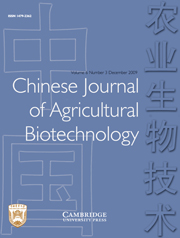No CrossRef data available.
Article contents
Purification and antibacterial activity of recombinant human lactoferrin in milk of transgenic mice
Published online by Cambridge University Press: 29 January 2010
Abstract
To verify its antibacterial activity, recombinant human lactoferrin (rhLF) was extracted from the milk of transgenic mice (Mus musculus) (PCL25 and AP) by gel filtration chromatography and analysed by sodium dodecyl sulphate polyacrylamide gel electrophoresis (SDS-PAGE), Western blot and enzyme-linked immunosorbent assay (ELISA). In addition, its bacteriostatic properties were tested using the agar disc diffusion method. ELISA analysis showed that the concentration of rhLF in the milk of transgenic mice ranged from 7 to 8 mg/ml, and the recombinant protein expressed in the milk had the same molecular weight as the native protein (~78 kDa), indicating that the rhLFs had a strong antibacterial activity on Escherichia coli and Salmonella.
- Type
- Research Papers
- Information
- Copyright
- Copyright © China Agricultural University 2009


